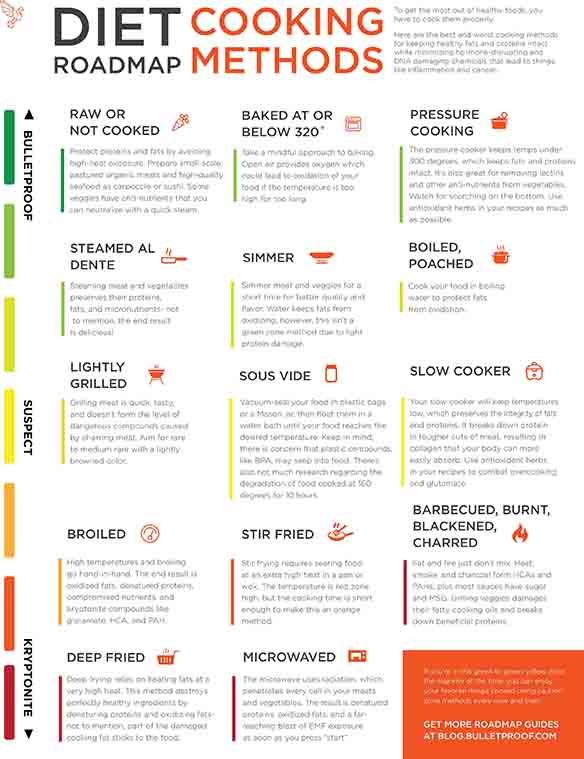
- When people make a change in their diets, the focus is on what or how much you eat. This is only part of the equation.
- Choosing the right foods is a start, but to get the most out of healthy foods, you have to cook them properly.
- Here are the best and worst cooking methods for keeping healthy fats and proteins intact while minimizing hormone-disrupting and DNA-damaging chemicals that lead to things like inflammation and cancer.
Usually, a diet program focuses on macro ranges (proteins, fats, etc.) or specific foods. The Bulletproof Diet differs in that it centers around keeping inflammation down. Of course, the foods you eat matter, but did you know that the way you cook your food has just as much of an impact on your inflammation as the type of food does?
Read on to find out why your cooking method matters, and which ones will push you further toward your whole-life upgrade.
Why cooking method matters
Before going through the good and the bad, it’s good to understand why you should pay attention to how you cook and process your food.
Cooking damages proteins
Protein structure plays a huge role in the way your body uses it. Excessive heat denatures proteins, which means the protein loses its shape. That doesn’t make the protein toxic, but it makes it difficult for your body to get full benefit from it. Proteins must be folded into their proper shape to function properly.
High heat produces carcinogens
The high temps and burning action that comes with smoking, frying, and grilling meat produces nasty compounds that you don’t want anywhere near your food. Cooking this way allows amino acids, sugars, and creatine to react, which produces heterocyclic amines (HCA). It also forms polycyclic aromatic hydrocarbons (PAH), which become a concern when burned particles stick to the outside of the meat, as it does with open-flame cooking. Both HCA and PAH causes mutations in DNA, which makes them pretty risky to eat. This process starts at around 320 degrees, so it’s best to keep your cooking temps lower than that.
Heating oils and fats oxidizes them
Good fats are clean energy, brain food, and serve countless other functions in the body. So, you want to protect them so that you can get maximum benefit when you eat them.
Different types of fats have different levels of stability. Saturated fats can withstand higher temperatures than polyunsaturated fats, which are highly unstable and go rancid quickly when heated. If you eat rancid or oxidized oils, your body ends up dealing with a lot of free radicals, which are molecules that damage your cells. Overheated fats also produce dicarbonyls that change DNA and may have a role in the development of cancer.[ref url=”www.ncbi.nlm.nih.gov/pubmed/23317342″]
Just like the food choices you make, your choices in cooking method can push you toward your goals or hold you back. The Bulletproof Cooking Methods Roadmap lays out cooking methods in the same way it does with food types — green zone is great for you, red zone will tank your performance, and there is a range of levels in between that you can decide how often you use them, if at all.
Get your copy here, and grab the Bulletproof Diet & Fasting Roadmap while you’re at it. Click image below to download.
Raw or not cooked
One way to protect proteins and fats from heat damage is to simply not expose them to heat. You might be wondering if this is safe, since you’ll be getting a good portion of your proteins and fats from animal products. Chances are, you’re eating a lot of these things raw anyway — grass-fed butter, sushi, or whipping up a low-carb ice cream recipe that calls for raw eggs.
Small-scale, pastured organic meats are far less likely to have the parasites and harmful microbes that mass-produced meats have. Factory farms are just plain dirty, and good sourcing goes a long way.
Steamed al dente
Steaming meat and vegetables preserves the proteins, fats, and micronutrients while making them taste far better than they would if you ate them raw. Steaming also breaks down a substantial portion of lectins and other plant defenses that sap your energy and cause inflammation.
As with any cooking method, you can overdo steaming if you let it go too long. Keep a close watch on meats and take them out as soon as they’re done to your liking. Steam vegetables until they’re crisp-tender, not mushy.
Baked at or below 320?
Baking has its pros and cons. You have full control of the oven temperature, which is a plus. On the flipside, the open air provides a lot of oxygen which could lead to oxidation if it cooks at a higher temperature, or for too long.
If you let your food bake for too long, you can end up with:
- Free radicals
- Denatured proteins
- Glutamate (which is toxic)
- Oxidized fats
All of these things cause inflammation.
Simmer
Simmering meats and veggies works well as long as the duration is short. The water keeps fats from oxidizing, but you still end up with some protein damage, and that’s why it’s not a green zone method. Overall, it’s a good way to cook food.
Boiled, Poached
As with simmering, boiling water surrounds the food completely, protecting the fats from oxidation. Boiling isn’t particularly appetizing for meats, but cooking meats in a soup adds enough flavor for a tasty result.
Lightly boiling vegetables pulls out plant defenses that block nutrients and tank your energy, so be sure to drain the water.
Lightly grilled (not charred)
A light, quick grill results in tasty meats, and doesn’t form the level of dangerous compounds that charring meats does. Shoot for rare to medium rare with a lightly browned outside.
Sous vide
Sous vide is a slow cooking method that uses a temperature-controlled water bath. You vacuum-seal your food in plastic or use zip-top bags, and float them until the food reaches the desired temperature — it can be an hour to all day, depending on what you’re making and your recipe.
If you were suspicious about the plastic bags, your instincts are on point. BPA and other endocrine disruptors from the plastic can find their way into your food. But, there’s a workaround — use a mason jar and pack it tightly to avoid airspace that will interfere with the process.
Slow cooker
Your slow cooker will keep temperatures low, which is fantastic to preserve the integrity of fats and proteins. It breaks down collagen in tougher cuts of meat, which produces a tender result full of collagen that your body can use.
Slow cookers are designed to run long, and you run the risk of overcooking your food and producing toxic compounds, just like you would by overcooking in the oven or on the stove. Using antioxidant foods and spices in your slow cooker recipes helps slow the oxidation process.
Broiled
You can’t broil without high temperatures. As you might expect, you’ll end up with oxidized fats, denatured proteins, compromised nutrients, and toxic compounds like glutamate (which creates impulses in nerve cells when they should be at rest), HCA and PAH.
This doesn’t mean you can never, ever broil your food. Broiled recipes are fine occasionally.
Stir fried
Stir frying requires an extra-high temperature pan or wok to sear the food quickly. The temperature is high enough to push it into the red zone, but the duration is short enough to bump back to orange.
To get the stir-fried experience with less damage, quickly steam your food then coat in a sauce made with green-zone ingredients. If the sauce isn’t sticking, toss it in a frying pan for a minute or less. The result won’t caramelize like a stir-fry, and it’s not green zone. It’s somewhere in the middle, but tastier than steamed and healthier than a true stir-fry.
Barbecued, burnt, blackened, charred
Everyone can agree that barbecued food tastes amazing, and you’ve surely been tempted by the smell of someone’s barbecue going miles away.
Problem is, fat and fire don’t mix. You end up with HCAs and PAHs from the heat and smoke, plus most sauces are sugar-based, and include neurotoxic MSG, which over-excites brain cells until they die off. Using these methods also produces glutamate, another neurotoxin. Glutamate and MSG are both excitatory to neurons, so it makes them fire when they shouldn’t, and that can cause neurological problems and degeneration. If you must play with fire, do a quick grill at a low temperature.
Deep fried
Deep frying relies on fats heated to super-high temperatures, which most certainly oxidize. When you fry your food, you take a perfectly good sweet potato or slice of beef and not only raise the temperature enough to oxidize its own fats and denature its own proteins, but a portion of the damaged fats stick to the food. Consider deep-fried foods inedible — they’re that risky.
Microwaved
Microwaving warms your food using radiation, which penetrates deep and reaches every cell in your meats and vegetables. The result is denatured proteins, oxidized fats, and a far-reaching blast of EMFs exposure (which is harmful radiation) as soon as you press “start.” Consider replacing yours with a steam convection oven, which should fit in the same spot.
If you’re in the green to green-yellow zone the majority of the time, you can enjoy your favorite things cooked using caution zone methods every now and then.


















